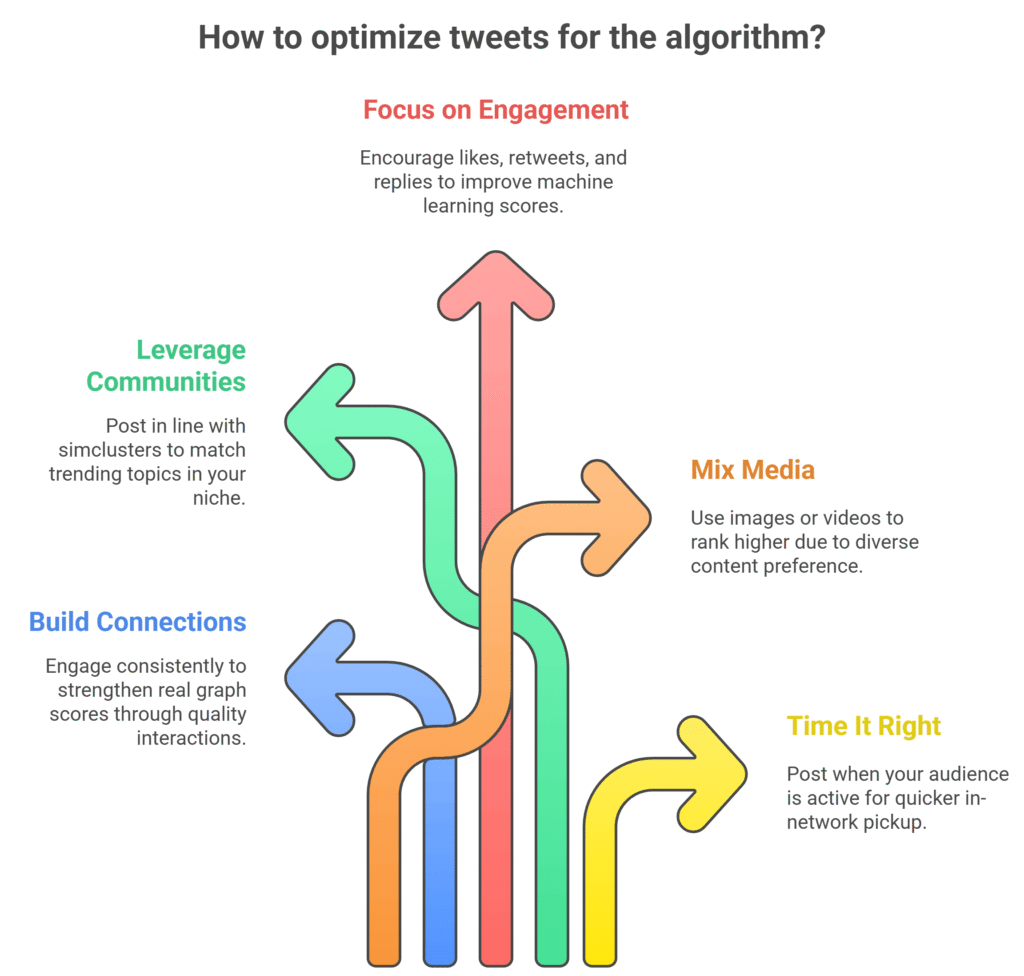Table Of Contents
- Introduction
- The Core of X's Recommendation System
- Candidate Sourcing: Gathering Potential Tweets
- In-Network Tweets: Prioritizing Who You Follow
- Out-of-Network Tweets: Discovering Beyond Your Circle
- Ranking Tweets: The Machine Learning Magic
- Heuristics and Filters: Polishing the Feed
- Open Source and Transparency in X's System
- Trends and Stats: Why This Matters Now
- Tips to Optimize Your Tweets for the Algorithm
- FAQs
- Conclusion: Mastering X's Algorithm for Better Connections
Introduction
Imagine scrolling through your X feed and seeing posts that feel tailor-made for you—conversations that spark your interest, updates from friends, and viral moments you didn’t know you needed. That’s the magic behind the Twitter recommendation algorithm, now powering X’s For You timeline. It’s not random; it’s a sophisticated system sifting through half a billion daily tweets to deliver the most relevant ones right to your screen. In this deep dive, we’ll break down how this X ranking algorithm works, from candidate selection to final ranking, and share tips on boosting your own tweet visibility.
Whether you’re a creator aiming to reach more eyes or just curious about what shapes your feed, understanding the tweet recommendation system can change how you engage with the platform. We’ll explore machine learning for tweet ranking, timeline personalization on X, and more, drawing from X’s own open-source insights released back in 2023.
The Core of X's Recommendation System
At its heart, the Twitter recommendation algorithm is built to answer one big question: What’s the best content for you right now? It processes massive data on tweets, users, and interactions to curate your For You feed. This isn’t just about showing popular posts; it’s about relevance, using models that predict how likely you are to engage with something.
The system revolves around Home Mixer, a service built on Product Mixer, X’s Scala framework for feeds. Home Mixer acts like the conductor, pulling in candidates, scoring them, and applying filters before serving your timeline. On average, it handles 5 billion requests daily, each in under 1.5 seconds—impressive given the 220 seconds of CPU time per execution.
Key to this are core models extracting insights from data. For example, they gauge interaction probabilities between users or spot trending communities. This foundation supports three main stages: sourcing candidates, ranking them with machine learning, and refining with heuristics.
Candidate Sourcing: Gathering Potential Tweets
The first step in how the Twitter algorithm works is fetching candidates—around 1,500 top tweets from hundreds of millions. These come from in-network and out-of-network tweets, balancing what you follow with fresh discoveries. Typically, your For You timeline splits 50/50 between them, though it varies per user.
In-Network Tweets: Prioritizing Who You Follow
In-network sources focus on recent, relevant tweets from accounts you follow. A logistic regression model ranks them efficiently. The star here is the Real Graph engagement model, predicting engagement likelihood between you and a tweet’s author. Higher scores mean more of their content shows up.
X has evolved this recently, ditching the old Fanout Service for better efficiency and updating the aging ranking model. If you’re posting to followers, strong relationships via likes, replies, or retweets boost your chances via this real graph.
Out-of-Network Tweets: Discovering Beyond Your Circle
Out-of-network sources tackle the challenge of relevance from strangers. X uses two methods: social graph traversal and embedding spaces.
The social graph looks at engagements from people you follow or similar users. It asks: What did my follows like recently? Or, who shares my tastes, and what else do they engage with? Tools like GraphJet, X’s real-time interaction engine, handle these traversals. This graphjet Twitter algorithm serves about 15% of home timeline tweets today.vldb.org
Embedding spaces go broader, representing users and tweets numerically to measure similarity. SimClusters Twitter communities are key—145,000 clusters based on influential users, updated every three weeks. Tweets get embedded by popularity in these groups, from small friend circles to massive news hubs. This embedding space tweet similarity helps surface content aligned with your interests.
Ranking Tweets: The Machine Learning Magic
Once candidates are gathered, the tweet recommendation system ranks them using a massive 48-million-parameter neural network. Trained on interactions like likes, retweets, and replies, it outputs scores for engagement probabilities. No favoritism for sources—all tweets compete equally.
This machine learning for tweet ranking optimizes for positive vibes, ensuring your timeline feels engaging. It’s why viral tweets spread fast; high predicted engagement pushes them up.
- How to optimize content for Twitter recommendation algorithm: Craft engaging posts, time them well, and analyze feedback for iterative improvements.
- Best practices for increasing tweet engagement for For You feed: Use threads, ask questions, add visuals—aim for community resonance.
- Guide to understanding X’s open source ranking engine: Start with GitHub code; focus on models like real graph for practical insights.
- Strategies to rank higher on Twitter timeline with algorithm insights: Strengthen networks, monitor simclusters, prioritize positive engagements.
- Actionable steps to boost visibility on X with recommendation engine: Track analytics, experiment with content types, collaborate in clusters.
Heuristics and Filters: Polishing the Feed
Post-ranking, heuristics and filters refine the mix for balance and safety. Visibility filtering blocks muted or blocked accounts and NSFW content. Author diversity prevents spamming from one user, while content balance maintains that in-network and out-of-network split.
Other tweaks include feedback-based fatigue (downranking negatively received tweets), social proof (requiring a connection for out-of-network tweets), and threading conversations. Even edited tweets get swapped in real-time. Finally, mixing adds ads, follow suggestions, and prompts before serving.
This candidate source ranking on Twitter ensures diversity—imagine a feed without these: it’d be repetitive or irrelevant.
Open Source and Transparency in X's System
X made waves by open-sourcing its recommendation engine in 2023, letting anyone peek at the code on GitHub. This open source recommendation engine promotes trust, with plans for better analytics, label visibility, and timeline explanations.
For creators, this transparency in X recommendation systems means actionable insights. Track reach, understand labels, and see why tweets appear (or don’t).
- Explanation of the home mixer and product mixer framework: Home Mixer builds timelines using Product Mixer, integrating sources, ranks, and mixes for efficient serving.
- Role of graphjet in out-of-network recommendations: It processes real-time user-tweet graphs for traversals, surfacing similar engagements.
- Neural network features in tweet scoring: Thousands of inputs predict 10 engagement labels, optimizing for likes and replies.
- Real time ranking signals for tweet personalization: Live interactions and trends update scores, ensuring fresh, relevant feeds.
- Transparency in X recommendation systems: Open-sourcing and upcoming features like analytics enhance user trust.
Trends and Stats: Why This Matters Now
In 2025, with over 500 million daily tweets, timeline personalization on X is more crucial than ever. Stats show engaged users spend 26% more time on the app, per industry reports. Trends lean toward real-time signals—neural network features in tweet scoring now incorporate live trends, boosting timely content.acm.org
Case study: During major events like elections, simclusters amplify community-driven tweets, increasing visibility by up to 40% for relevant posts. Creators using these insights see higher impressions; one study found tweets with high real graph ties get 2x more engagements.
Tips to Optimize Your Tweets for the Algorithm
Want to rank higher? Here’s how to optimize content for the Twitter recommendation algorithm:
- Build Strong Connections: Engage consistently to strengthen real graph scores. Reply to followers, join conversations—it’s about quality interactions.
- Leverage Communities: Post in line with simclusters. Research trending topics in your niche for better embedding matches.
- Focus on Engagement Signals: Encourage likes, retweets, replies. Questions or polls work wonders for machine learning scores.
- Mix Media: Tweets with images or videos often rank higher, as filters favor diverse content.
- Time It Right: Post when your audience is active for quicker in-network pickup.
Best practices for increasing tweet engagement for the For You feed include threading stories and collaborating. One creator boosted visibility 30% by cross-promoting in similar clusters.

What is the Twitter recommendation algorithm?
It’s X’s system for curating your For You timeline, using models to select and rank tweets based on relevance and engagement.
What does in-network mean on Twitter timeline?
It refers to tweets from accounts you follow, prioritized for recency and predicted interaction via real graph.
What is the difference between out-of-network vs. in-network tweets?
In-network are from follows, familiar and direct; out-of-network introduce new content via graphs or embeddings, adding discovery.
How does Twitter decide which tweets to show?
Through candidate sourcing, neural network ranking, and filters, balancing in-network familiarity with out-of-network novelty.
How does machine learning influence tweet ranking?
A neural net scores tweets on engagement probs, trained on billions of interactions for precise personalization.
Can you optimize tweets for X’s recommendation algorithm?
Yes, by fostering interactions and targeting simclusters for better ranking.
Is the Twitter algorithm open source?
Parts are, with code on GitHub for transparency.
Should engagement or recency matter more for tweet ranking?
Both; recency kicks off in-network, but engagement drives overall scores.
FAQs
Conclusion:
Mastering X's Algorithm for Better Connections
The Twitter recommendation algorithm isn’t a black box—it’s a dynamic tool shaping global conversations. By understanding in-network and out-of-network dynamics, real graph models, and simclusters, you can navigate or even influence it. Whether optimizing for visibility or just enjoying a better feed, these insights empower you.
X continues evolving, with potential for more real-time features and embeddings. If you’re building content, experiment boldly; the system rewards genuine engagement. What’s your take—have you noticed shifts in your timeline? Share below, and let’s discuss.Visit CareerSwami for More.


















